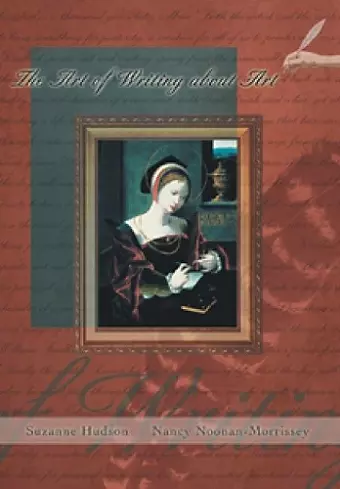Custom Enrichment Module: The Art of Writing About Art
Suzanne Hudson author Nancy Noonan-Morrisey author
Format:Paperback
Publisher:Cengage Learning, Inc
Published:25th May '01
Currently unavailable, our supplier has not provided us a restock date

THE ART OF WRITING ABOUT ART is designed for ease of use and can serve as a quick reference for students writing various types of essays, research papers, exhibition reviews, or even examinations. The premise of the book is that students in all disciplines, not just English, should be required to write well and that their instructors should hold these writing assignments to high standards. THE ART OF WRITING ABOUT ART not only emphasizes skills in college-level composition, but also in verbalizing the experience of art-the historical, social, economic, and political forces that shape art and artists; art theory; and the interplay between artist and viewer.
Introduction. Why Write About Art? How Will This Book Help? 1. Principles of Effective Writing. The Four Modes of Discourse. Narration. Description. Exposition. Argument. Types of Writing about Art. Essays. Critical Essays. The Comparative Essay. The Formal Analysis. The Exhibition Review. Research Papers. Other Types of Writing about Art. The Artist's Statement. Museum and Gallery Labels Catalogue Entries. Approaches to Art Criticism. Diaristic Art Criticism. Formalistic Art Criticism. Contextualist Art Criticism. Psychoanalytical Art Criticism. Ideological Art Criticism. The Process for Writing About Art. Planning Your Essay. Choosing a Topic. Posing a Research Question. Researching Your Topic and Taking Notes. Finding a Thesis. Identifying the Counterarguments. Asking the Proof Question. Designing Your Points of Proof. Outlining Your Essay. Writing Your Essay. Writing the Introduction. Organizing the Evidence. Writing the Body Paragraph. Writing the Conclusion. Citing Your Sources. Writing a Title. Revising, Editing, and Proofreading Your Paper. Formatting Your Paper. 2. TheLanguage of Art and the Formal Analysis. TheLanguage of Art. Subject Matter. Formal Elements. Principles of Design. Medium. Style or "ISM". Writing theFormal Analysis. Planning theFormal Analysis. Writing theFormal Analysis. A Sample Formal Analysis Essay. "Chantet Lane: A Post-Impressionist Walk in theAmerican Southwest" by Ron Baxendale Revising, Editing, and Proofreading Your Paper. Revision Checklist. 3. Writing the Expository Essay. Planning Your Essay. A Sample Expository Essay. "Strength in Stone: Michelangelo's David," by Nancy Noonan-Morrissey. Topic Suggestions for Expository Essays. Templates for Planning the Expository Essay. Sample Expository Essays. "Gothic Nightmares in Romantic Painting," by Rachel Gothberg. Organizing the Comparison-Contrast Essay . "Don't Worry, Be Happy: Minoan Art and Architecture," by Donald Coffelt. "Nobility in Human Suffering in theWork of Theodore Gericault," by Rachel Gothberg. Revising, Editing, and Proofreading Your Paper. Revision Checklist. 4. Writing the Argumentative Essay. Choosing a Topic. Topic Suggestions. Planning the Argumentative Essay, Writing the Introduction. Thesis. Points of Proof. Template for Organizing the Argumentative Essay. Writing the Body Paragraphs. A Sample Argumentative Essay. "American Myths, Patriotism, and Art," by Luis Vigil. Revising, Editing, and Proofreading Your Paper. Revision Checklist. 5. Writing the Essay Examination. Preparing for the Examination. Taking the Examination. Before You Begin Writing. Preparing to Answer theEssay Question. Writing theEssay. Sample Essay Examination Question and Answer. Before Turning in theExam. 6. Writing the Review. Audience and Purpose. A Sample Review. "Knavery, Trickery, and Deceit," by Karen Wilkin. Visiting theGallery or Museum. Written Material at the Show or Exhibition. Audio Program. Moving through the Exhibition. Organizing Your Material. Writing the Introduction. Writing a Working Thesis. Developing a Controlling Idea for Your Introduction. The Historical Introduction. The Unpopular Opinion. The Analogy. What I Expected versus What I Got. The Comparison. The First Impression. Strength of the Artist. The Question. Ending the Introductory Paragraph with a Thesis. Writing the Body Paragraphs. Theme. TheArtist(s). Description of Works. Subject Matter. The Formal Elements. Principles of Design. The Medium. The Style or "Ism". Uniqueness. Comparable and Influential Artists. Social Context. Historical Reference. Exhibition Display. Writing theConclusion. The Historical Conclusion. The Quotation. Welcome or Congratulations. The Final Impression. Predict theFuture. One Work of Art. Writing a Title. Revising, Editing, and Proofreading Your Review. Revision Checklist. 7. Writing the Research Paper. Choosing a Topic. Researching theTopic. Searching theLibrary. Finding Books. Finding Periodical Articles. Finding Newspaper Articles. Searching the Internet. Templates for Planning the Research Paper. Writing Your Research Paper. Using Sources. Paraphrasing versus Plagiarizing. Original Passage from Source. Illegitimate Paraphrase. Legitimate Paraphrase. Incorporating Quotations into Your Paper. Acknowledged Quotation: Correct. Unacknowledged Quotation: Incorrect. Citing Sources. Notes. First, Full Reference. Second, or Subsequent, References. Bibliography. A Sample Research Paper: "Ben Shahn's Use of Photography in His Paintings," by Peter Scaliese. MLA (Modern Language Association) Documentation System. Models for Parenthetical Source Citations. Special Punctuation Considerations When Citing Sources. The Works Cited Page. A Sample Research Paper. "The Elgin Marbles: Saved or Stolen?," by Emily O'Connor. Revising, Editing, and Proofreading Your Research Paper. Revision Checklist. Handbook. Definitions of Basic Terms. Parts of Speech. Sentence Parts. Sentence Types. Choosing Words. Choosing Verbs. Choosing Pronouns. Wordiness. Nonsexist Language. Tone. Sentence Structures. Sentence Fragments. Run-on Sentences. Awkward Sentence Constructions. Punctuation. Comma. Semicolon. Colon. Dash. Apostrophe. Quotation Marks. Using Other Punctuation Marks with Quotation Marks. Credits. Notes. Bibliography.
ISBN: 9780155061545
Dimensions: 235mm x 160mm x 10mm
Weight: 318g
240 pages